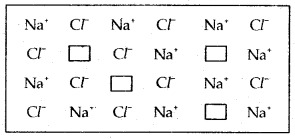The Solid State Class 12 MCQs Questions with Answers

Question 1. Which of the following transition metal oxides is paramagnetic? (a) TiO (b) VO (c) Cu2O (d) Mn2O3 Answer Answer: (b) VO Question 2. Which of the following transition metal oxides is not an insulator? (a) MnO (b) NiO (c) VO (d) Mn2O3 Answer Answer: (c) VO Question 3. Coordination number in ccp and hep arrangements of metal atoms are respectively. (a) 6, 6 (b) 12, 6 (c) 8, 6 (d) 12, 12 Answer Answer: (d) 12, 12 Question 4. An example of body centered cube is (a) Sodium (b) Magnesium (c) Zinc (d) Copper Answer Answer: (a) Sodium Question 5 Fe3O4 is ferrimagnetic at room temperature but at 850 K it becomes (a) Diamagnetic (b) Ferromagnetic (c) Non-magnetic (d) Paramagnetic Answer Answer: (d) Paramagnetic Question 6. Which of the following is not an example of 13-15 compounds, (a) InSb (b) GaAs (c) CdSe (d) Alp Answer Answer: (c) CdSe Question 7. For tetrahedral coordination, the radius ration (r+/r ) should be (a) 0.155-0.2...
